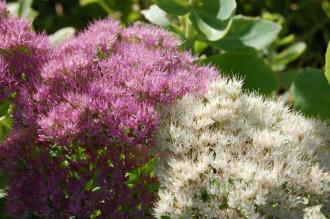
Sedum spectabile ‘Stardust’ (08/09/2012, Kew gardens, London)
Position: Full sun to partial shade
Flowering period: Late summer to early autumn
Soil: Moist, well drained
Eventual Height: 50cm
Eventual Spread: 50cm
Hardiness: 3a – 10a
Family: Crassulaceae
Sedum spectabile ‘Stardust’ is a fast growing herbaceous perennial with a clump forming habit. Its grey/ green leaves are fleshy, elliptic with entire margins, up to 10cm long and 5cm broad. Its grey/ green stems are thick and also fleshy. Its pink and white flowers appear on separate flat terminal cymes each of which are up to 15cm across.
The species Sedum spectabile, commonly known as the Ice Plant, Showy Stonecrop and Butterfly Stonecrop, is native to eastern Asia including China, Korea and Manchuria. Sedum spectabile is synonymous with Hylotelephium spectabile.
The etymological root of the binomial name Sedum is derived from the Latin sedo ’settle’, a name used by Pliny describing how the cushion species of this genus hug the rocks. Spectabile is derived from the Latin specto ‘to behold’, in reference to the flower heads.

Sedum spectabile ‘Stardust’ Flower (08/09/2012, Kew gardens, London)
The landscape architect may find Sedum spectabile ‘Stardust’ useful as part of a mixed herbaceous planting scheme. It may be included within a wildlife garden as it is very attractive to bees. Once established this plant is drought tolerance.
Ecologically, Sedum spectabile ‘Stardust’ is very attractive to pollinating insects.
Sedum spectabile ‘Stardust’ prefers moist, fertile, well-drained soils. It tolerates most pH of soil.
Sedum spectabile ‘Stardust’ requires little maintenance. For a tidy appearance it may be cut to near ground level in spring. In my opinion the heads should be left on the plant during the winter months.

